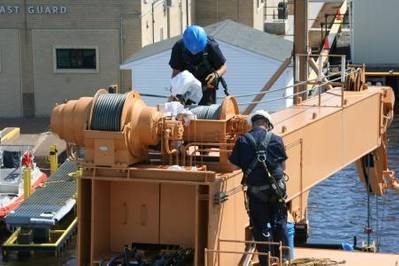Great Lakes Coast Guard's Operation Fall Retrieve Underway
In anticipation of the coming ice season and to ensure the safety of vessels transiting the Great Lakes Basin, earlier this week the Coast Guard 9th District began its annual retrieval of the Great Lakes and St. Lawrence Seaway System seasonal aids to navigation, the largest domestic ATON recovery operation in the U.S.
Operation Fall Retrieve, which affects lighted and unlighted buoys and beacons, commenced Tuesday with a goal of retrieving 1,278 navigational aids. The operation is scheduled to be completed by Dec. 28.
The 1,278 aids, approximately half in the region, are taken out of service during the winter months due to decreased vessel traffic and are replaced with smaller, lighter and more buoyant buoys, known as wintermarks or ice hulls, that are designed to actually ride underneath the ice when it comes, but still stay on location.
The 9th District's ATON system facilitates safe and efficient maritime activity in the Great Lakes and St. Lawrence Seaway region by marking safe passage for domestic, international, commercial and recreational vessel traffic.
“Properly marked waterways are essential to keeping commerce moving on the Great Lakes during the winter,” said William Sharp, a marine information specialist with the 9th District’s Waterways Management Branch. “Safe navigation is crucial no matter the season.”
The Coast Guard manages 3,127 fixed and floating federal aids in the region. The waters of the U.S. and its territories are marked to assist navigation by the U.S. Aids-to-Navigation System.
This system employs a simple arrangement of colors, shapes, numbers and light characteristics to mark navigable channels, waterways and obstructions adjacent to them. ATON can provide a boater with the same type of information drivers get from street signs, stop signals, road barriers, detours and traffic lights. These aids may be anything from lighted structures, beacons, day markers, range lights, fog signals and landmarks to floating buoys.
“There is still a lot of vessel traffic throughout the Great Lakes during the winter months,” Chief Warrant Officer Ralph Kugel, the ATON manager with the 9th District’s Waterways Management Branch. “ It is important to maintain the navigational channels.”
Each aid has a purpose and helps mariners determine their location, stay out of danger, and provide safer navigation from one place to another.
To accomplish Operation Fall Retrieve, the district will employ six Coast Guard cutters, five ATON Teams; five small boat stations with ATON duties; the Lamplighters, civilian employees who manage the inland waters of Northern Minnesota; Canadian Coast Guard crews; and the Saint Lawrence Seaway Development Corporation.
In addition, members of the Coast Guard Auxiliary help inspect about 3,000 privately-owned aids to navigation in the region. For more information on Operation Fall Retrieve or to contact the district unit in your area that is participating in the operation, contact the district’s Public Affairs Office at 216-902-6020.
uscg.mil














